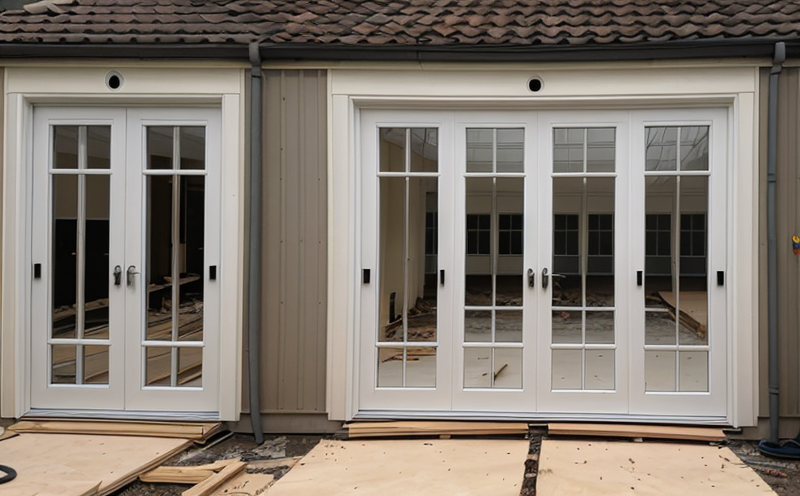Smoke Leakage Testing for Door Assemblies
Smoke leakage testing is a critical aspect of fire safety design and compliance. Doors are pivotal in preventing the spread of smoke during fires, ensuring that people can evacuate buildings safely. This section focuses on how we perform smoke leakage tests on door assemblies to ensure they meet the necessary standards.
The test involves measuring the amount of smoke that leaks through gaps around a door assembly when exposed to fire. The goal is to determine whether the door meets specified levels of integrity and resistance to the passage of smoke. This testing is essential for ensuring that doors can function effectively in real-world emergencies, which are often unpredictable.
Smoke leakage tests comply with international standards such as ISO 16728 and EN 13955-4:2003. These standards define the methodology and acceptance criteria required to pass this test. The test setup typically includes a door assembly placed in a testing chamber where it is exposed to controlled fire conditions.
Specimen preparation involves ensuring that the door, including any hardware such as locks or closers, is installed on its frame correctly. Gaps around the door are carefully measured and documented before testing begins. This meticulous preparation ensures accurate test results.
The instrumentation used in smoke leakage tests includes a smoke chamber, a gas analyzer to measure smoke density, and calibrated smoke generators. The process involves subjecting the door assembly to a fire for a specified duration while monitoring the amount of smoke that escapes through any gaps around it. The results are compared against the acceptance criteria outlined in the relevant standards.
Once testing is complete, a detailed report is generated that includes all test parameters, specimen preparation details, and the final results. This comprehensive report ensures that stakeholders have clear evidence regarding the door assembly's performance during smoke leakage tests.
Benefits
The benefits of conducting smoke leakage testing on door assemblies are numerous. First, it enhances occupant safety by ensuring that doors perform as expected in emergencies. This is crucial for compliance with fire safety regulations and codes such as NFPA 80 and EN 13955-4:2003.
Secondly, successful smoke leakage testing can lead to certification, which can be a significant advantage when bidding on contracts or marketing products internationally. It demonstrates that the door assemblies meet stringent quality standards.
Additionally, regular testing helps in identifying any potential weaknesses in design or manufacturing processes early, allowing for corrective actions before they become critical issues.
Industry Applications
| Application Area | Description |
|---|---|
| Data Centers | Data centers require robust fire safety measures to protect valuable equipment and personnel. Smoke leakage tests ensure that doors can contain smoke effectively in case of a fire. |
| Healthcare Facilities | Hospitals and clinics need reliable exit routes during emergencies. Smoke leakage testing ensures that doors function correctly, minimizing the risk of smoke inhalation for patients and staff. |
| Offices & Commercial Buildings | In commercial settings, fire safety is paramount to protect assets and ensure employee safety. Testing helps maintain compliance with local regulations and international standards. |
| Residential Complexes | Smoke leakage tests are crucial for residential areas where quick and safe evacuation is vital in case of a fire. |
The data center application specifically highlights the importance of containing smoke within confined spaces to prevent the spread of fires. In healthcare facilities, reliable doors can save lives by ensuring that patients and staff have safe routes out of buildings during emergencies. For offices and commercial buildings, compliance with fire safety regulations is essential for maintaining a secure working environment. Residential complexes benefit from tests that ensure the integrity of exit routes.
Quality and Reliability Assurance
- Consistent Compliance: Ensures that all door assemblies meet the necessary fire safety standards, such as NFPA 80 and EN 13955-4:2003.
- Precision Measurement: Utilizes advanced instrumentation to accurately measure smoke leakage, providing reliable data for analysis.
- Documentation: Generates detailed reports that document all test parameters and results, enhancing transparency and accountability.
- Repeatable Tests: Allows for consistent testing procedures across multiple door assemblies, ensuring uniform quality standards.
These measures ensure that the tests are not only accurate but also repeatable, providing confidence in the reliability of the results. By adhering to these quality and reliability assurance practices, we can provide clients with peace of mind knowing their fire safety solutions meet the highest standards.





